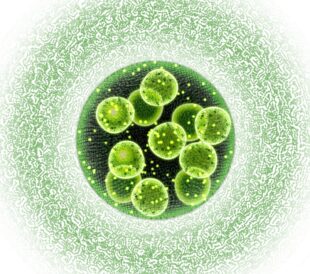
Since humans started building permanent structures in which to live, even as far back as the Babylonians around 4,000 B.C., we have sought to get our waste as far away from ourselves as possible.1 That effort has continued to the modern-day, where the sewers under our feet carry billions of gallons of waste (every day!) away from our most populated areas.2
It is the pinnacle of ‘out of sight, out of mind.’
But in flushing and forgetting our waste, we are also flushing a wealth of information about our biology and the infectious diseases that threaten our health. What if, we could use our waste to spot the outbreak of disease before a community even starts to show symptoms? It’s a powerful thought and one that could change public health. And it’s not new. The concept of pathogen detection through wastewater testing is centuries old.
Monitoring the Complexities of the Human Microbiome
What makes wastewater pathogen detection so valuable is the incredible quantity of microbes that live within our digestive tracts. These microbes, comprising the gut microbiome, play an incredible (though poorly understood) role in overall human health, for everything from digestion to cardiac health to the immune system.3,4 Viruses, bacteria, fungi, and other microbes form a complex system within the gut, competing with invading pathogens for attachment sites and nutrients, aiding in carbohydrate digestion, producing vitamins, and more. Many biological functions that need to be executed for us to survive are carried out by the human microbiome. We can find evidence of the organisms contained within it in the fecal matter we eliminate and draw conclusions about the health of the subject or community from where it came. While the concept of getting this waste far away from where we live may be as old as human settlement, the idea to utilize that same waste to monitor health and disease on both the individual and community level is a much more recent development, dating back to the 19th century.
Wastewater Surveillance Through the Centuries: A Timeline
The first waterborne disease to be scientifically documented was the Broad Street cholera outbreak of 1854 in London.5 Impressively, Dr. John Snow (the father of epidemiology, not of Winterfell) was able to convince local officials of the disease’s source and vehicle of transmission decades before germ theory had been proven.6 Snow managed this feat by comparing the water sources of disease-stricken and untouched households and tracked the outbreak to a single pump on Broad Street. Ever since, epidemiologists have looked to water for answers about how diseases are spread, and how they might be tracked without relying on large-scale individualized testing.
In the 1940s, epidemiologists utilized wastewater to track and contain disease outbreaks in the United States, particularly polio.7 The cell culture methods used were crude by today’s standards, but effective nonetheless, and wastewater surveillance remains a critical tool for eradicating polio across the globe.8 Still, many pathogens are either difficult or impossible to culture, and more efficient and cost-effective methods have been developed, like hybridization with radioactive cDNA probes to monitor Hepatitis A in the 1980s.9 It wasn’t until the 1990s, however, that the gold standard of wastewater pathogen detection techniques was brought to the front lines with PCR.10,11
Because PCR can be quick and efficient, detection of pathogens in wastewater can be done even before those infected start to show symptoms.12 Recently, innovative and highthroughput PCR-based workflows have been used for ongoing monitoring of the COVID-19 pandemic. As nasal swab testing was limited and often delayed in the early stages of the global spread of SARS-CoV-2, wastewater testing was suggested as a way to bypass some of the bottlenecks in our testing infrastructure and identify areas where outbreaks were just starting, long before case numbers, hospitalizations, and deaths took off. Some universities used this strategy to identify which dormitories required individual testing. A recent study from a university may be good resource to add to this list (They used the KingFisher Flex platform). Here is the link to the preprint. Rapid, large-scale wastewater surveillance and automated reporting system enabled early detection of nearly 85% of COVID-19 cases on a University campus.
Modernizing the Approach to Wastewater Surveillance
While wastewater detection shows immense promise, both for the current pandemic and beyond, a detection method is only as effective as the quality of extracted proteins or nucleic acids (DNA or RNA) allows it to be. Our MagMAX Microbiome Ultra Nucleic Acid Extraction Kits can help with the challenging sample types required for microbiome detection and wastewater testing. And there’s a bonus: The kit is automation-ready, allowing higher throughput with Thermo Fisher’s KingFisher Flex sample purification system. Automated protocols require less hands-on time and enable faster workflows. Together, these products empower research and clinical laboratories to work smarter, not harder, and streamline processes to allow for high-throughput DNA/RNA extraction, suitable for many downstream applications.

KingFisher system-optimized kits, reagents, and protocols that can be used to maximize purity and yield for each extraction target and sample type. MagMAX kits are best suited for automated extraction of DNA or RNA due to their ease of use and reliability.
We should probably continue our practice of eliminating our waste from the places we live, but that doesn’t mean we have to flush the countless opportunities to improve our health by leveraging the vast information contained in such undesirable substances and sample types. From studying how disruptions of microbiota contribute to cancer to stopping the next global pandemic in its tracks, the answer could be in what we put in our toilets. And our KingFisher
and MagMAX systems can help your lab get the most out of every unmentionable bit.
If you’re interested in learning more about our automated extraction and purification systems for pathogen detection or other uses, contact us to set up a demonstration of the KingFisher Microbiome Kit or read about our other automated solutions in sample preparation and extraction.
This article is for Research Use Only. Not for use in diagnostic procedures.
________________________________________________________________________________________________________________________
References for Wastewater Testing and Surveillance
1. Lofrano G, Brown J. Wastewater management through the ages: a history of mankind. Sci Total Environ. 2010;408(22):5254-5264.
2. Wastewater Treatment System. NYC Environmental Protection website: https://www1.nyc.gov/site/dep/water/wastewater-treatment-system.page. Accessed June 28, 2021.
3. Cénit MC, Matzaraki V, Tigchelaar EF, Zhernakova A. Rapidly expanding knowledge on the role of the gut microbiome in health and disease. Biochim Biophys Acta. 2014;1842(10):1981-1992.
4. Kordalewska M, Markuszewski MJ. Metabolomics in cardiovascular diseases. J Pharm Biomed Anal. 2015 Sep 10;113:121-36.
5. Cameron D, Jones IG. John Snow, the broad street pump and modern epidemiology. Int J Epidemiol. 1983;12(4):393-396.
6. Buechner JS, Constantine H, Gjelsvik A. John Snow and the Broad Street pump: 150 years of epidemiology. Med Health R I. 2004;87(10):314-315.
7. Metcalf TG, Melnick JL, Estes MK. Environmental virology: from detection of virus in sewage and water by isolation to identification by molecular biology–a trip of over 50 years. Annu Rev Microbiol. 1995;49:461-487.
8. Brouwer AF, Eisenberg JNS, Pomeroy CD, et al. Epidemiology of the silent polio outbreak in Rahat, Israel, based on modeling of environmental surveillance data. Proc Natl Acad Sci U S A. 2018;115(45):E10625-E10633.
9. Jiang X, Estes MK, Metcalf TG. Detection of hepatitis A virus by hybridization with singlestranded RNA probes. Appl Environ Microbiol. 1987;53(10):2487-2495.
10. Toze S. PCR and the detection of microbial pathogens in water and wastewater. Water Res. 1999;33(17):3545-3556.
11. Erlich HA, Gelfand D, Sninsky JJ. Recent advances in the polymerase chain reaction. Science. 1991;252(5013):1643-1651.
12. Hellmér M, Paxéus N, Magnius L, et al. Detection of pathogenic viruses in sewage provided early warnings of hepatitis A virus and norovirus outbreaks. Appl Environ Microbiol. 2014;80(21):6771-6781.
13. More And More Colleges Testing Student Poop For Coronavirus : NPR website:https://www.npr.org/2020/10/26/925831847/colleges-turn-to-wastewater-testing-in-aneffort-to-flush-out-the-coronavirus. Published October 26, 2020. Accessed June 28th,2021




Leave a Reply